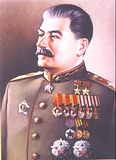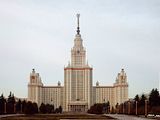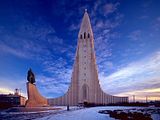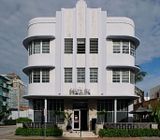1940's
The Pentagon is the headquarters of the United States Department of Defense, located in Arlington, Virginia. As a symbol of the U.S. military, "the Pentagon" is often used metonymically to refer to the Department of Defense rather than the building itself.

Designed by architect George Bergstrom (1876 - 1955) and built by Philadelphia, Pennsylvania general contractor John McShain, the building was dedicated on January 15, 1943 after ground was broken for construction on September 11, 1941. It is the highest-capacity office building in the world and the fourth largest building in the world by floor area. It houses approximately 23,000 military and civilian employees and about 3,000 non-defense support personnel. It has five sides, five floors above ground (plus two basement levels), and five ring corridors per floor with a total of 17.5 miles (28.2 kilometers) of corridors.

____________________________________________________________________
Joseph Stalin

General Secretary of the Communist Party of the Soviet Union's Central Committee from 1922 until his death in 1953. Although Stalin's formal position originally had little significant influence, his office being nominally but one of several Central Committee Secretariats, Stalin's increasing control of the Party from 1928 onwards led to his becoming the de facto party leader and the dictator of his country, in full control of the Soviet Union and its people. His crash programs of industrialization and collectivization in the 1930s and his campaigns of political repression cost the lives of millions of people. However it helped industrialize the Soviet Union making a Great power by 1931. By 1937 the Soviet Union had become the second largest industrial nation in the world.
Under Stalin's leadership, the Soviet Union played the decisive role in the defeat of Nazi Germany in the Second World War (1939-45) more commonly known as The Great Patriotic War in Russia and post-Soviet republics and went on to achieve the status of superpower, expanding its territory to a size similar to that of the former Russian Empire excluding most of Finland, Poland and Alaska.
____________________________________________________________________
Starlinist Architecture
Some Never Built, Some Standing Today. Many grandiose Stalinist architectural projects churned out from the mid 1930s to the early 1950s. However, the projects came at staggering costs such that most never got beyond the drawing board, at a time when the country was lying in ruins. Stalinist architecture is not, per se, an architectural style characterized by its distinct appearance. Instead it describes an architecture that resulted from the way the state communicated with the masses through its constructions, using them as an expression of state power.

Stalinist architecture (also referred to as Stalin's Empire style or Socialist Classicism) is a term given to architecture of the Soviet Union between 1933, when Boris Iofan's draft for Palace of Soviets was officially approved, and 1955, when Nikita Khruschev condemned "excesses" of the past decades and disbanded the Soviet Academy of Architecture.
Features
Stalinist architecture is not, per se, an architectural style characterized by its distinct appearance. Instead it describes an architecture that resulted from the way the state communicated with the masses through its constructions, using them as an expression of state power. The combination of striking parade monumentalism, patriotic art decoration and traditional motifs has become one of the most vivid examples of the Soviet contribution to architecture.
The ensemble that a Stalinist building will contain can be very broad, not only in the overall motif, but also in the technology that lies underneath the rich decorations.
In the Soviet policy of rationalisation of the country, all cities were built to a general development plan. Each was split into districts, with allotments drawn based on the city's geography. Projects would be drawn up for whole districts, visibly transforming a city's architectural image.
Every point in a design had to gain the approval of the state. Criticism of a project could vary from minor recommendations to total disapproval. As a result many had to be modeled and remodeled many times. This also had a direct effect on the architects themselves, many of whom would later describe this period not by what was actually built, but on what they were not allowed to include. For example, the floral motifs of Art Nouveau were never allowed.
The interaction of the state with the architects would prove to be one of the focal points of this time. The same building could be declared a formalist blasphemy and then receive the highest praise the next year.Authentic styles like Zholtovsky's Renaissance Revival, Ivan Fomin's St. Petersburg Neoclassical Revival and Art Deco adaptation by Alexey Dushkin and Vladimir Schuko coexisted with pale imitations and eclectics that became a symbol of that era.
http://en.wikipedia.org/wiki/Stalinist_architecture#Technology
http://www.thethinkingblog.com/2007/08/gothic-stalinist-soviet-skyscrapers.html
Legacy and Revival
In 1947, the Soviet government adopted a resolution concerning the construction of high-rise buildings in Moscow. By the early 1950s, tall buildings had been erected (see below). Albeit smaller than the projects above, nevertheless very impressive. Note the striking similarities between the style of architecture, especially the resemblance of current White House in Moscow to the Aeroflot Building project above.
Only the construction of a 32-floor administrative building in Zaryadye, which was envisaged as one of the salient features of the silhouette of the central city skyline, was not completed. Work on it was stopped after the 1955 resolution of the Central Committee, which condemned "excesses and over-ornamentation in architecture" and signalled a new era in Soviet architecture. The work which had been done was dismantled, and the hotel Rossiya was built on the foundations in 1967.

http://architecture.about.com/library/weekly/aa090501k.htm
http://www.horn-ok-please.com/Imperial-Russia-and-Modern-Russia.htm
_____________________________________________________________________
Hallgrímskirkja
The Hallgrímskirkja (literally, the church of Hallgrímur) is a church in Reykjavík, Iceland. At 74.5 metres (244 ft), it is the third tallest building in Iceland after Longwave radio mast Hellissandur and Smáratorg tower. The church is named after the Icelandic poet and clergyman Hallgrímur Pétursson (1614 to 1674), author of the Passion Hymns.
State Architect Guðjón Samúelsson's design of the church was commissioned in 1937. It took 38 years to build the church. Construction work began in 1945 and ended in 1986, the landmark tower being completed long before the church's actual completion. The crypt beneath the choir was consecrated in 1948, the steeple and wings were completed in 1974. The nave was consecrated in 1986. It is situated in the centre of Reykjavík and is visible throughout the city. It has become one of city's best known landmarks.
The church houses a large pipe organ by the German organbuilder Johannes Klais of Bonn. It has mechanical action, four manuals and pedal, 102 ranks, 72 stops and 5275 pipes. It is 15 metres tall and weighs 25 tons. Its construction was finished in December 1992. It has been recorded by Christopher Herrick in his Organ Fireworks VII.
The church is also used as an observation tower. An observer can take a lift up to the viewing deck and view Reykjavík and the surrounding mountains.
There is a statue of the explorer Leifr Eiriksson in front of the church, predating its construction. It was a gift from the United States on the 1930 Althing Millennial Festival, commemorating the 1000th anniversary of Iceland's parliament.

____________________________________________________________________
Art deco
Art Deco was a popular design movement from 1920 until 1939, affecting the decorative arts such as architecture, interior design, and industrial design, as well as the visual arts such as fashion, painting, the graphic arts, and film. This movement was, in a sense, an amalgam of many different styles and movements of the early 20th century, including Constructivism, Cubism, Modernism, Bauhaus, Art Nouveau, and Futurism. Its popularity peaked during the Roaring Twenties. Although many design movements have political or philosophical roots or intentions, Art Deco was purely decorative. At the time, this style was seen as elegant, functional, and ultra modern.
Art deco in the 1940's
Although Art Deco fell out of vogue in the 1940s, it has had small rebirths over subsequent decades. Its designs frequently appear in modern architecture, entertainment, and media when a "classic retro" look is sought. In media, such examples are obvious in Batman: The Animated Series from the early 1990s in which the show's creators used Art Deco styling fused with a deliberate darkness to create an Art Deco variant style often referred to as Dark Deco. Films such as Sky Captain and the World of Tomorrow, Dick Tracy, and King Kong have various Art Deco elements as well. In Marilyn Manson's The Golden Age of Grotesque, he demonstrates an Art Deco style mixed with his Gothic trademark.

_______________________________________________________________________
Astakhovsky (Yauzsky) Bridge (1940)
Astakhovsky (Acтаховский) Bridge across Yauza was built in 1940 by I.N.Golbrodsky (structural engineering) and I.V.Tkachenko (architectural design) on the site of old Yauzsky Bridge (1804), 250 meters upstream from Yauza mouth. Total length 46.4 meters, width 36 meters (8 lanes), concrete lattice type

1 comment:
Hello, I was curious as to where you got the image of Stalin from?
Post a Comment